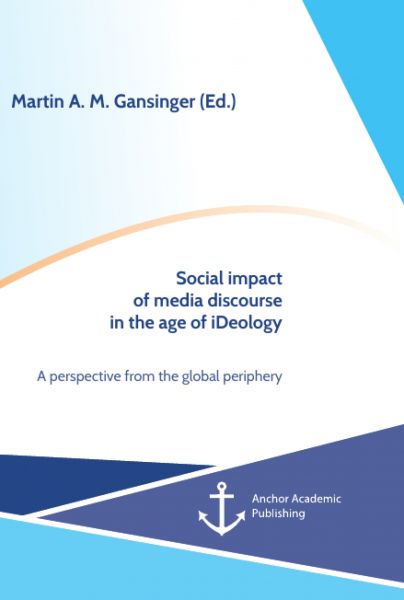Social impact of media discourse in the age of iDeology. A perspective from the global periphery
In the age of iDeology – in which individual access and participation to technology is about to replace the rich texture of religion, culture, tradition and political convictions – the social impact of media discourse only magnifies. This volume is an attempt to explore the influence of ever-available communication content on the minds and behavior of a population that has made the permanent and often obsessive use of communication technology a defining element of social orientation. Unlike the many accounts that focus on the remarkably redefined patterns in the context of Western society – ranging from twittering Presidents to the emerging populist movements all over Europe – this volume portrays the situation from the frequently neglected perspective of the global periphery. As opposed to simply transfer and measure perspectives taken from a Western point of view, the clear intention of this volume is to provide ample space for the sincere and explorative consideration of local characteristics and settings of the different social, cultural and political contexts and therefore contribute to providing the ground for future research.
Text sample:
Chapter 3: Literature review:
There is a vast body of work examining the potential of the media to influence its audience. Within the legal context, this too has been a focal point for discussion and various studies have been executed for the purpose of seeking to determine whether and to what extent the actors within the judicial system are affected by media discourse and portrayals and depictions of law and the legal system. The studies undertaken present diverse and differing approaches in analysis of media discourse and its potential influence. However, many of them attempt to evaluate the effect that the media may have on the outcome of trials and the sentencing in both civil and criminal cases. Quite a few works analyze how increased exposure to media content – whether it includes depictions of crimes or their victims, critical content of lenient or harsh sentencing, commentary on damage awards or the progression of cases through the judicial system – would affect the outcome of cases. Studies undertaken in the United States of America have evaluated the relationship from a different angle, assessing how the extent of coverage of judges and case outcomes may influence future decisions and thus, through increased scrutiny, enhance consistency (Lim, Snyder & Strömberg, 2010). Similarly, other works indicate that the extent of influence may depend on the manner of appointment of judges (such as election-based selection), particularly where the discourse in the media relates to or reflects public opinion on certain issues (Lim, Snyder & Strömberg, 2010; Beale, 2006).
Studies analyzing the relationship between the related media content and the outcome of trials or sentencing have shown that there is a lack of influence or comparatively reduced extent of influence where cases are heard by professional judges. This is notably identified as being on account of their professional training and experience and thus mitigated media bias (Philippe & Ouss, 2018). As such, the inclusion of lay persons into the judicial system in the form of juries and their important role in determination of guilt and/or sentencing thus sets foundations for the importance of investigation of media influence in this context. This is particularly heightened when taking into consideration the significant consequences of criminal trials and the lack of evaluation of jurors regarding their media use and exposure prior to the fulfillment of their duties. With judgements devoid of outside influence and external factors being the cornerstone of the right to fair trial, any potential of the media to influence lay persons „has clear implications for fair trials” (Thomas, 2010, p. 50). Reflecting an acknowledgment of the potential related discourse of the matter in the media may have in influencing the decision-makers in criminal cases, the United Kingdom Contempt of Court Act 1981 creates liability for publication of material contents on active legal proceedings that carries a substantial risk of prejudice to the case and the administration of justice through its influence on actual/potential jurors. As such, it is clearly reflecting the potential of the published material to affect those that are exposed to it. Similarly, and again taking into consideration the capacity for influence, trials have been scheduled in a manner that ensures that jurors are not exposed to media content with potentially negative depictions of scenarios that resemble the case at hand (Greene, 1990, p. 439).
Hence, existing literature suggests the existence of influence and variation of sentencing in situations of increased exposure to certain media content. A recent approach, aiming at determining the extent of influence of media on juries in France (Philippe & Ouss, 2018) showed that increased reference to crime on television news broadcasts the night before (unrelated) verdicts were given resulted in the increase of sentences by an average of twenty-six days. Similarly, a correlation was noted whereby media content reporting judicial errors reflected in reduced sentencing. Comparable results have been presented by other authors (Greene, 1990), thus clearly indicating the potential influencing capability of media content. Further conclusions convey that the published content will continue to influence and remain with the jury members during trial deliberation where there is less time between the exposure to discourse in the media and jury duty, the content relates to a higher profile case or issue, or an increased extent of the reporting of similar crimes (Thomas, 2010, p. 41). However, methodologies for the implementation of studies for the determination of media influence on verdicts and sentencing do vary and reach from mock-examinations and case simulation to post-case surveys among jury members in order to evaluate their extent of recollection (Thomas, 2010). Additionally, the extent of exposure and content of media discourse is evaluated.
While several approaches focus on analyzing official reporting of case outcomes before the courts, the determination of trial dates in advance generates difficulty for analyzing the media content and influence when it specifically refers to the case itself. Therefore, a preference can be seen throughout the studies for the comparative evaluation of media content independent of and unrelated to the cases before the courts, with the sentencing provided in the same periods. Philippe and Ouss (2018) analyzed outcomes of trials rendered after more media coverage against those verdicts pronounced coincidentally after less media content on similar topics for determining correlations and therefore potential media influence on the sentencing provided by lay members of the judiciary.
Local context:
In the Turkish Republic of Northern Cyprus, the structure of the judicial system is set out mainly in the Constitution and the Courts Law of 1976 (Law No. 09/1976). According to the Courts Law, the TRNC District Courts, sitting in the districts of Nicosia, Famagusta, Kyrenia, Güzelyurt, Iskele and Lefke have capacity to hear both civil and criminal cases falling within their jurisdiction. In 2017, eight district presidents, ten senior judges and sixteen district judges presided over the cases submitted to the District Courts. The cases are allocated to judge chambers based on the amount/value of dispute in question (Court Activity Report, 2017, p. 4). The type of criminal cases heard in the district courts are police, traffic and „other”. Those cases deemed to be serious criminal cases under the relevant laws and Criminal Code are, according to the Courts Law (Law No. 9/1967) Article 31, heard in the Ağur Ceza Court (equivalent to a „serious crimes court”). Article 30 of the Courts Law notes that there are three such courts situated in Nicosia, Famagusta and Kyrenia. The serious criminal cases are presided over by a panel comprised of one district judge, one senior judge and one district court president to be allocated to position by the Supreme Court (Article 30 of the Court Law). Where it is deemed to be necessary, for example due to shortage of those in office, the Law notes that a district judge may be appointed in place of the senior judge, and a senior judge may be appointed to sit in place of the president within the panel. In 2017, the serious criminal court was presided over by the normal panel (Court Activity Report, 2017, p. 3).
The appointment of persons to judicial office as a judge to the district courts and the Ağur Ceza Courts (from those exercising the legal profession or prosecutorial duties in the TRNC) is exercised by the Yüksek Adiye Kurulu („High Judicial Board”) under the authority of Article 141 of the TRNC Constitution and Article 18 of the Courts Law. According to Article 19 of the Courts Law, appointment to district judge requires five years of professional experience, senior judge requires eight and appointment to president ten years. Upon appointment, there is no training course, nor legal requirement to undertake continued professional training. In a much similar manner as can be seen in other jurisdictions, the notion of independence of the judiciary from other branches of governance is enshrined in Article 136 of the TRNC Constitution. Important for the present context is the reference to the independence of those holding judicial office with the reference in Article 136 to the judges passing judgement based on the provisions of the Constitution, laws and, in so far as it is in line with the law, conscience. This is mirrored in Article 4 of the Courts Law (Law No. 1976), with the provisions of neutrality reflected in the oath of judges upon their appointment, as set out in Article 5 of Courts Law.
Dr. Martin Abdel Matin Gansinger (born 1979 in Austria) studied Communication Science and Political Science at the University of Vienna. He conducted long-term field studies on extemporaneous communication and traditional culture in Ghana, Morocco and Cyprus and regularly publishes work on contemporary aspects of philosophy, ethics and religion in the context of media and popular culture. Next to his professional experience as a journalist and PR coordinator and affiliations with universities in Germany and Cyprus he is currently based in France and works as an author and editor for various international publishing houses.
Versandkostenfreie Lieferung! (eBook-Download)
Als Sofort-Download verfügbar
- Artikel-Nr.: SW9783960677239458270
- Artikelnummer SW9783960677239458270
-
Autor
Martin A. M. Gansinger
- Verlag Anchor Academic Publishing
- Veröffentlichung 23.05.2019
- Barrierefreiheit
- ISBN 9783960677239

